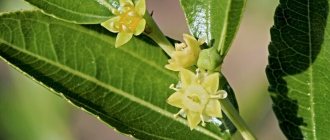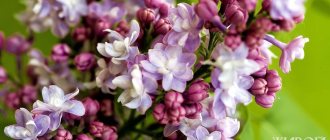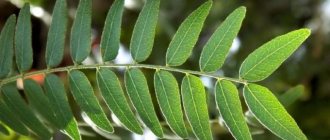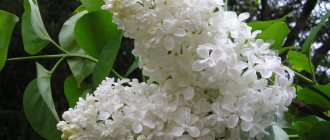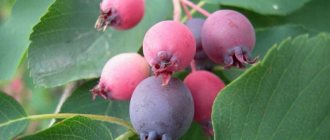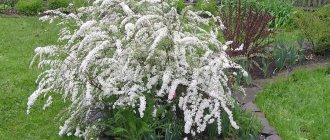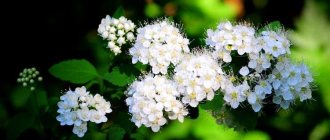Hazel or hazel (Corylus) is a representative of the Birch family. This genus is represented by deciduous trees and shrubs. It unites approximately 20 species. They are found naturally in North America and Eurasia. At the same time, in coniferous-deciduous forests they form undergrowth. The most popular type among gardeners is hazelnut or common hazel. The following cultivated species are often called hazelnuts: large hazel, Pontic hazel and common hazel. The hollow is one of the oldest cultivated plants in Europe. For many centuries, hazel has been cultivated in Spain, France, Great Britain, Turkey, Italy and Germany. Hazel fruits appeared on the territory of Russia in 1773 in the process of exchange for velvet and leather. The word hazel comes from “leska”, which means hazelnut.
A little history
Archaeologists claim that the plant was known to mankind long before the advent of fire. For example, hazelnuts appeared in the Caucasus more than 6,000 years ago.
As now, in those distant years, hazel nuts were used both as a tasty delicacy and to quickly satisfy hunger. Moreover, nuts do not require very difficult storage conditions.
In Russia, cultivated hazel appeared thanks to the efforts of I.V. Michurin; it grew wild and continues to grow in ordinary forests, enjoying the constant popularity of local residents.
But even today it is almost impossible to find hazelnuts in ordinary summer cottages, and there is no mention of growing nuts on an industrial scale.
Where does Hazel grow?
The geography of distribution of the shrub is quite extensive. Asia Minor is considered its homeland, but hazel is found in coniferous-deciduous forests not only in Eurasia. It even grows in America. The plant is popular and cultivated in many countries.
Hazel does not tolerate heat well. Found naturally in temperate climates. This is also true for garden species. They will not die, but the ideal temperature for dusting (+12 degrees) will not be achieved, and, therefore, there will be no fruits
Useful properties of hazel
Hazelnut fruits contain a huge amount of vitamins and minerals vital for the human body. Nuts quickly satisfy your hunger, so they can be a healthy snack during the day. They are used in cooking, pharmaceuticals, and cosmetology.
Walnut wood is considered a fairly valuable material for the production of furniture and tools, although most often small trees are used to produce garden tools, and flexible branches are used to create wickerwork or openwork decorative items.
The plant itself will be a pleasant decoration for any summer cottage. It:
- Perfectly protects the area from dust and gases from the street;
- It pleases with rich green foliage, and in the fall it turns into a bright yellow spot, elegantly standing out among the dull grayness.
Hazel often strengthens the slopes of ravines, and it itself miraculously fills areas of felling and fires, hiding all traces of destructive human activity in just a few years.
Nutritional value and chemical composition
There are 657 kcal per 100 g of hazel nuts. This nut is an energetically valuable product. An amazing fact is that hazelnut (photo in the article) has a high protein composition, identical to egg white - 17.2 g contains 18 amino acids. This easily digestible vegetable protein allows you to do without meat.
Hazel nuts also contain:
- fats – 70%;
- carbohydrates – 19.2%;
- vitamins of group B, C, E, A, etc.;
- minerals (magnesium, manganese, potassium, copper, zinc, calcium, iron, phosphorus, iodine, etc.);
- alimentary fiber.
Hazel leaves contain many essential oils and glycosides. And the bark contains betulin, alcohols and tannins.
Description of hazel
Hazel belongs to the Birch family. In Russia, it does well in the North Caucasus and Central Russia.
Most often it grows as a shrub, reaching a height of 1.5-2 meters, sometimes, mainly after human intervention, it becomes a tree, capable of growing up to 7-10 meters.
- Flowers appear in late March-early April even before the first leaves appear.
- The fruiting period for a wild tree begins in 6-8 years; cultivated plants can produce a harvest already in the fifth year of life.
- From one hazel you can collect up to 10 kilograms of nuts, although such abundance will not be available every year.
- After abundant fruiting, hazel can rest for several years.
The fruits grow in 3-4 pieces, each nut weighs about 5 grams.
The plant has a powerful root system, but all the roots are located close to the surface, so the hazel itself will not be able to obtain adequate food for itself without the help of its owners.
Types and varieties of plants, appearance
Tree-like hazel has a powerful root system with a lush crown up to 3-7 meters high. It has many shoots that are covered with bark with transverse patterns. The leaves are quite large and rough, light green in color. In autumn the leaves turn reddish or yellow.
Today there are more than 100 species of this plant. The most popular variety is considered to be “Panahesskiy”, which has a very pleasant taste. Next come the German varieties “Gustav” and “Louise”, as well as the French “Miracle of Bolvillera”, which are very resistant to winter and have large fruits.
The following varieties are well suited for cultivation in our area: “Antey”, “Tambovsky early”, “Komsomolets”, “Pushkinsky red”, etc.
Selecting a location
Hazel is not particularly demanding for cultivation, but the choice of planting site must be approached as responsibly as possible.
- The ideal area would be a place on the south or west side, where there is a lot of light and there are no drafts or strong winds.
- Groundwater should lie below 1.5 meters from the surface, but lowlands in which water accumulates during floods or heavy rains will also not please the plant.
- So does heavy soil. The ideal soil is loose, fertile soil with neutral or slightly increased acidity.
There should be at least 4-5 meters to the nearest trees.
Harm and contraindications
The main contraindication for use is individual intolerance to hazel components. Also, you should not exclude hazel nuts for people who:
- diathesis;
- severe diabetes;
- chronic diseases of the liver and gall bladder.
Hazel leaves are contraindicated for people with high blood pressure. Nut kernels are contraindicated in people with skin diseases, as they can aggravate them.
Pit preparation
The planting pit is prepared approximately a month before the expected date of planting of the new inhabitant of the site. When planting hazelnuts in the spring, it is advisable to prepare the hole in the fall.
- If there is light and fertile soil, a depth of 50 centimeters will be sufficient; if the soil does not have high nutritional properties, the depth is increased to 80 centimeters.
- Fertile soil is poured into the hole; rotted manure, ash or superphosphate can also be added there. It is advisable to put a few handfuls of earth pulled out from under wild hazel on top. It contains beneficial fungi that help the seedling to take root faster in a new place.
The plant is placed on a small mound inside the hole and carefully covered with fertile soil. The soil is compacted, the tree is tied to a strong stake, and the planting site is watered abundantly.
One plant will require at least 40 liters of water. When the moisture leaves, the tree trunk circle is covered with mulch, which will help retain moisture for a long time.
For better pollination, it is recommended to plant several hazels in one area at once. And it is advisable to use different varieties for planting.
Varieties of hazelnuts
There are more than 20 species in the hazelnut genus. The diversity of cultures of this kind is simply amazing. Plants have significant differences, but almost all tolerate frost well and are distinguished by their longevity.
Red viburnum is a shrub or tree - description
Hazel grows well in any type of soil; it is unpretentious, but it is better to bear fruit in fertile soil. The nut loves moisture, but its excess can harm the plant. In an open, sunny area, hazel will be decoratively attractive and produce a good harvest. Among all the types of hazel, there are several of the most common.
Common hazel, or hazelnut
The common hazel variety reaches a height of 6 m. The tree has an extremely attractive crown. What distinguishes common hazel from classical varieties is its flowering, which begins before the leaves bloom. Bees are especially interested in this shrub.
Note! When other trees are just beginning to prepare to bloom, hazel is already in full bloom and provides nectar to insects.
Bear nut, or tree hazel
Bear nut, or tree hazel, stands apart among all types of wild hazel. This plant grows up to 20 m high. The diameter of the walnut crown is 8 m. The slender and attractive trunk is a distinctive feature. The tree is recognized by its wide pyramidal crown shape. During the season it gives a big increase. The plant tolerates drought, shaded areas and frost well.
Hazelnut
Pleasant neighborhood
In order for the plant to grow better, it is recommended to plant lupine, oats, vetch, and mustard in the tree trunk circle.
These plants, when mowed, will become an excellent mulch layer, helping to make the soil more loose and provide the hazel with useful substances.
Hazel tree care
Hazel is not too demanding in terms of care. For the first time after planting, it is recommended to shade the seedling from too active sun. In the future, the sun's rays will only please the plant.
But the plant will feel great in a little shade.
- Watering. It is recommended to water hazel once a month, but these recommendations do not take into account weather conditions, so in hot periods the frequency of water application is increased, and in rainy summers it is reduced. At least 40-60 liters of water are poured under an adult plant at a time; for young seedlings this figure can be halved.
- Feeding. The plant is usually fed three times per season: in the spring, adding nitroammophoska, in June, using wood ash, in July, again using nitroammophoska. Once every three years, humus or rotted manure is added under the plant.
- Loosening and weeding. Both operations are performed as needed. Additional loosening is recommended about a day after watering or rain.
- Trimming. The shoots are trimmed constantly as they appear. In the spring, sanitary pruning is carried out, removing broken, damaged, dried, diseased branches, as well as branches growing inside the crown. Adult plants that have reached the age of 20 years already need rejuvenating procedures. In this case, one branch whose age exceeds seven years is pruned annually. For adult hazels that already refuse to bear fruit, you can cut off almost all the branches, leaving a few shoots with 2-3 strong buds. To form a tree, only one most powerful shoot is left.
- Wintering. Young plants (up to three years old) require covering with special materials; the flexible branches of the bush can simply be bent to the ground and covered with spruce paws. In this case, thin branches will be protected not only from the cold, but also from the wind, and therefore will not break and will more easily survive a difficult period. Mature plants can cope well with the cold on their own.
How hazelnuts bloom
Hazelnuts have flowers of different sexes. As a rule, male ones are in the form of earrings, while female ones resemble small kidneys. From each bud, up to 5 earrings are formed, the length of which is 10 cm. The female flower consists of a pistil and an undeveloped perianth.
At the moment when the temperature outside reaches +12°C and above, the active growth of earrings begins, and they develop much faster in dry weather. In rainy weather, flowering will be late. After the formation of earrings has come to an end, the release of pollen begins. The ovaries are formed after 2 months - at the beginning of summer.
Particularly dangerous are frosts that occur during the period when female flowers have already been pollinated. In this case, you can lose almost the entire harvest. Shelters are used to protect hazelnuts from frost. For Siberia, you can choose winter-hardy varieties that will not freeze in the spring. It is worth considering that the flowering of this type of hazelnut will be long and late.
Attention! The flowering period occurs at the end of March or at the beginning of April.
Hazel tree propagation
There are several ways to breed hazelnuts. The easiest way is to buy a ready-made seedling from a reliable company, but for those who want to experience the whole process, you can use:
- By layering;
- Cuttings;
- Dividing the bush;
- Seeds.
But the last option is considered the most unreliable and difficult.
Cute hazel will be a wonderful decoration for the site and a source of tasty and healthy fruits that will certainly appeal to all household members.
What are the benefits of hazelnuts at home?
Hazelnuts can be grown at home. The main thing is to choose the right place for planting so that the hazel begins to actively grow and bear fruit. Thanks to this, there will always be a useful product in the house that can be used in various folk recipes for therapeutic purposes.
With regular consumption of hazelnuts, you can cope with chronic fatigue. This property of the product is useful at a time when a person has heavy physical work or has small children. With constant exhaustion, the functioning of the immune system deteriorates. This leads to the appearance of many unpleasant diseases. Hazelnuts are suitable for the prevention and treatment of such diseases.
Advice!
Many doctors recommend eating hazelnuts to prevent cardiovascular diseases. To improve absorption, it is recommended to consume nuts with honey and dried apricots.
Despite the fact that the calorie content of hazelnuts is very high, doctors strongly recommend consuming them for obesity. The main thing is not to exceed the permissible daily intake. It will be enough to fill you up without getting extra calories. If a person often experiences stress that he is used to eating, then it is best to eat hazelnuts at such moments. It will serve as an excellent tool for maintaining a beautiful and fit figure, as well as relieve nervous tension and restore the functioning of internal organs.
